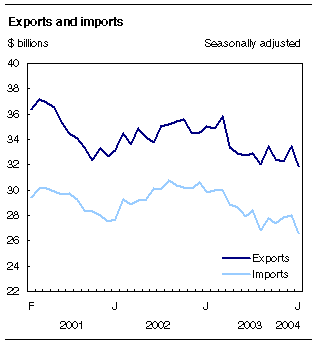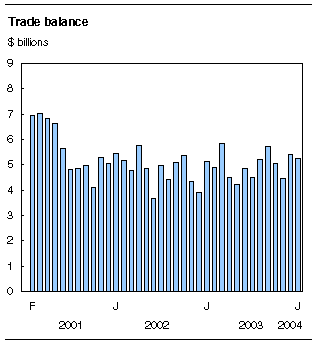
















 |
|
 |                |
Information identified as archived is provided for reference, research or recordkeeping purposes. It is not subject to the Government of Canada Web Standards and has not been altered or updated since it was archived. Please "contact us" to request a format other than those available.

|

Wednesday, March 10, 2004 Canadian international merchandise tradeJanuary 2004Merchandise exports were weak in January, as sales abroad dropped 4.7% from December. Imports fell a sharper 5.0% and the resulting trade surplus fell marginally to $5.2 billion. 
Automotive products caused the lion's share of trade declines, accounting for over half of the decline in exports and over a third of the decline in imports. Canadian companies reported sending $31.8 billion in goods abroad in January. Exports have declined in 7 of the last 10 months, and the 4.7% drop from December was the largest in nine months.
Imports fell from December to $26.6 billion, their lowest level since June 1999. In January, the Canadian dollar continued its appreciation against the US dollar. There were widespread decreases in both exports and imports with all of Canada's principal trading areas in January, a total reversal from December. Canada's trade surplus with the United States slipped slightly to $7.3 billion, mainly the result of stalled automotive trade. Exports south of the border fell 4.0% to $26.0 billion, while imports declined 4.2% to $18.7 billion. 
Canada's total trade deficit with countries other than the United States remained unchanged at $2.1 billion. New Year arrival does little to spur export growthAfter export values weakened throughout 2003, the first month of 2004 did little to improve the international trade outlook for Canadians, as exports values declined for every major commodity sector except energy products. Automotive exports, showing much volatility throughout the second half of 2003, have declined more than 10% in three of the last four months, as manufacturing plants and dealerships faced consumer uncertainty in the market. January's widespread weakness was led by an 11.4% drop in passenger cars, Canada's largest automotive category. Trucks and motor vehicle parts declines were less severe, but more than offset December's growth. Machinery and equipment exporters sold $394 million less than in December (-5.5%), the result of weak exports of industrial machinery and a variety of other equipment and tools. Strong aircraft exports offset some of these declines. Combine exports of automotive products and machinery and equipment account for over 40% of all Canadian merchandise exports. Labour disruptions affected some metal ore trade in January, causing sharp drops of over 60% for both zinc and copper ores. Aluminum, including its alloys, fell 16.5% and, along with other small commodity groups, pushed the industrial goods and materials sector down 5.7% to $5.7 billion. Exports of other wood fabricated materials, which include oriented strand board and related products, fell 13.8% in January to $554 million, continuing the erosion from November's record levels. Despite sustained US housing demand, lumber exports have slipped for the last four months. Lumber prices rose marginally in January, following their fourth quarter decline. Energy products showed the only positive change. Exports of crude petroleum alone jumped more than $500 million to a record monthly high of $2.1 billion. This was only the third time since January 2003 that crude petroleum exports exceeded natural gas exports, which were $2.0 billion for the month. Significant drop in passenger auto importsImports declined in all major sectors in January, with the largest occurring in automotive products, primarily passenger autos. Automotive imports fell 8.1% to $5.7 billion. Excluding the blackout-affected month of August 2003, this was the largest monthly percentage drop since January 2001. Weak sales and high inventories drove passenger auto imports down 20.8% to $1.7 billion, even though purchase incentives still remain, albeit at a reduced level. The machinery and equipment import drop in January ended back-to-back monthly gains for the sector. Aircraft, engines and parts slowed after two solid months, down 33.9% to $465 million, about half of their January 2003 level. Weaker imports of cellular telephones also contributed to the machinery and equipment declines. Crude petroleum imports fell 15.1% to $941 million, almost entirely on reduced volumes, as prices rose a mere 1.1%. Natural gas imports returned to more normal levels while lower imports of petroleum and coal products also contributed to the overall 17.3% energy decline. Industrial goods and materials imports were down 2.3%, as decreases in metals and metal ores were only partly offset by strong organic chemical imports. Agricultural imports sank, as the discovery of a case of mad cow disease in the United States in late December further discouraged trade in this industry. Coupled with an abundant domestic supply, this resulted in a plunge in beef imports for January. Available on CANSIM: tables 226-0001, 226-0002, 227-0001, 227-0002, 228-0001 to 228-0003 and 228-0033 to 228-0040. Definitions, data sources and methods: survey numbers, including related surveys, 2201, 2202 and 2203. The January 2004 issue of Canadian International Merchandise Trade (65-001-XIB, $15/$151) is now available. The publication includes tables by commodity and country on a customs basis. Current account data (which incorporate merchandise trade statistics, service transactions, investment income and transfers) are available quarterly in Canada's Balance of International Payments (67-001-XIB, $32/$100; 67-001-XPB, $44/$133). Merchandise trade data are available in PDF format on the morning of release. Data on Canadian international merchandise trade for February will be released on April 14. For more information on the publications, contact Jocelyne Elibani, (1-800-294-5583; 613-951-9647). To enquire about the concepts, methods or data quality of this release, contact Matthew MacDonald (613-951-8551), International Trade Division.
| |||||||||||||||||||||||||||||||||||||||||||||||||||||||||||||||||||||||||||||||||||||||||||||||||||||||||||||||||||||||||||||||||||||||||||||||||||||||||||||||||||||||||||||||||||||||||||||||||||||||||||||||||||||||||||||||||||||||||||||||||||||||||||||||||||||||||||||||||||||||||||||||||||||||||||||||||||||||||||||||||||||||||||||||||||||||||||||||||||||||||||||||||||||||||||||||||||||||||
|
|
|